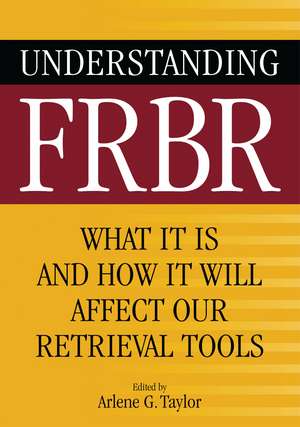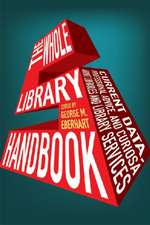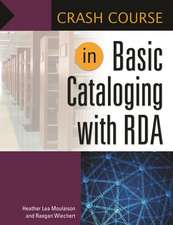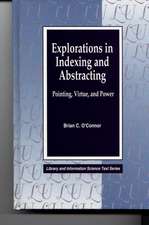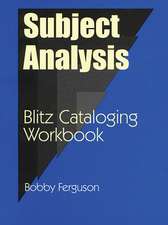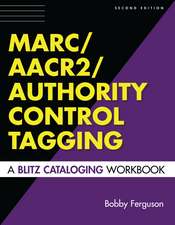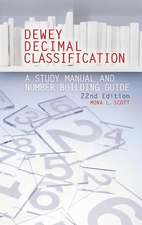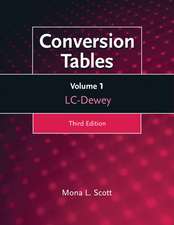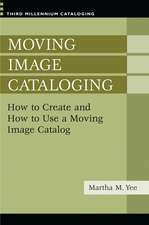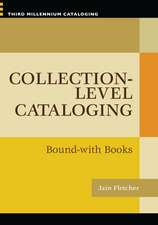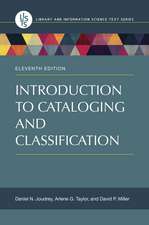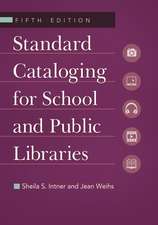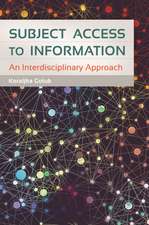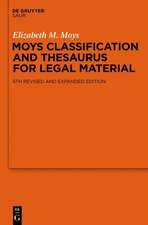Understanding FRBR: What It Is and How It Will Affect Our Retrieval Tools
Autor Arlene G. Tayloren Limba Engleză Paperback – 29 noi 2007 – vârsta până la 17 ani
Preț: 306.04 lei
Preț vechi: 374.13 lei
-18% Nou
Puncte Express: 459
Preț estimativ în valută:
58.58€ • 63.65$ • 49.24£
58.58€ • 63.65$ • 49.24£
Carte tipărită la comandă
Livrare economică 21 aprilie-05 mai
Preluare comenzi: 021 569.72.76
Specificații
ISBN-13: 9781591585091
ISBN-10: 1591585090
Pagini: 192
Dimensiuni: 178 x 254 x 12 mm
Greutate: 0.41 kg
Editura: Bloomsbury Publishing
Colecția Libraries Unlimited
Locul publicării:New York, United States
ISBN-10: 1591585090
Pagini: 192
Dimensiuni: 178 x 254 x 12 mm
Greutate: 0.41 kg
Editura: Bloomsbury Publishing
Colecția Libraries Unlimited
Locul publicării:New York, United States
Notă biografică
Arlene G. Taylor is Professor Emerita, School of Information Sciences, University of Pittsburgh, and author of several works on cataloging and classification and authority control. She has received ALA's Margaret Mann Citation in Cataloging and Classification and the ALA Highsmith Library Literature Award.
Cuprins
IntroductionChapter 1: An Introduction to Functional Requirements for Bibliographic Records (FRBR) by Arlene G. TaylorChapter 2: An Introduction to Functional Requirements for Authority Data (FRAD) by Glenn E. PattonChapter 3: Understanding the Relationship between FRBR and FRAD by Glenn E. PattonChapter 4: FRBR and the History of Cataloging by William DentonChapter 5: The Impact of Research on the Development of FRBR by Edward T. O'NeillChapter 6: Bibliographic Families and Superworks by Richard P. SmiragliaChapter 7: FRBR and RDA (Resource Description and Access) by Barbara B. TillettChapter 8: FRBR and Archival Materials by Alexander C. ThurmanChapter 9: FRBR and Works of Art, Architecture, and Material Culture by Martha Baca and Sherman ClarkeChapter 10: FRBR and Cartographic Materials by Mary Lynette LarsgaardChapter 11: FRBR and Moving Image Materials by Martha M. YeeChapter 12: FRBR and Music by Sherry L. VellucciChapter 13: FRBR and Serials by Steven C. ShadleIndexAbout the Editor and Contributors
Recenzii
Understanding FRBR. . . features chapters contributed by leading authorities in the cataloging field. . . . It offers a basic introduction to FRBR, discussions about FRBR, FRAD (functional requirements for authority data), and RDA (resource description and access), and the issues involved in using FRBR in nontraditional library settings such as with cartographic materials and music. Both books are well illustrated and include numerous bibliographical resources.' [Reviewed in conjuntion with FRBR: A Guide for the Perplexed].
Understanding FRBR is clearly written, well illustrated (many of the concepts are clarified by very helpful diagrams), and well indexed; additionally, chapters feature extensive bibliographies, many of which provide URLs to the IFLA groups' documents. While it may seem that this book is of interest only to catalogers, the application of FRBR will change the structure of catalog and the systems used to store and display it; therefore, it is an important text for systems librarians, reference librarians, and anybody else interested in the future of the organization and display of bibliographic information.
The emergence of this textbook is testimony to the breadth and depth of work done to date. It documents much of that work, and provides a good basic introduction to FRBR that is broadly understandable. . . . The relational concepts within FRBR are complicated and can be challenging. This book does a good job of illuminating them in a straightforward manner. It also describes how the application of the FRBR concepts could improve our systems of bibliographic access in very specific ways. . . . For those of us that really want or need to be able to predict the impact that FRBR will have on our work, this is an accessible explanation of the current state of the art. As such it is a real contribution to our understanding.
Taylor and her contributors cover FRBR and introduce the reader to FRAD as well. . . . All chapters conclude with current and useful references to further reading and more information.
Arlene Taylor and her compadres don't even try to teach you how to construct a hierarchical record. Instead, they direct their efforts toward showcasing what's possible when digital technology and traditional cataloging practice meet. This is the future of cataloging.
Understanding FRBR is a useful and timely book that brings together recent developments in FRBR and offers several assessments of it.
No cataloguer, bibliographic systems designer or library and information science lecturers and students should be without this book. It is a useful resource in acquiring an understanding of what FRBR is about and how it will change the way in which cataloguers will think about cataloguing in future.
Understanding FRBR is clearly written, well illustrated (many of the concepts are clarified by very helpful diagrams), and well indexed; additionally, chapters feature extensive bibliographies, many of which provide URLs to the IFLA groups' documents. While it may seem that this book is of interest only to catalogers, the application of FRBR will change the structure of catalog and the systems used to store and display it; therefore, it is an important text for systems librarians, reference librarians, and anybody else interested in the future of the organization and display of bibliographic information.
The emergence of this textbook is testimony to the breadth and depth of work done to date. It documents much of that work, and provides a good basic introduction to FRBR that is broadly understandable. . . . The relational concepts within FRBR are complicated and can be challenging. This book does a good job of illuminating them in a straightforward manner. It also describes how the application of the FRBR concepts could improve our systems of bibliographic access in very specific ways. . . . For those of us that really want or need to be able to predict the impact that FRBR will have on our work, this is an accessible explanation of the current state of the art. As such it is a real contribution to our understanding.
Taylor and her contributors cover FRBR and introduce the reader to FRAD as well. . . . All chapters conclude with current and useful references to further reading and more information.
Arlene Taylor and her compadres don't even try to teach you how to construct a hierarchical record. Instead, they direct their efforts toward showcasing what's possible when digital technology and traditional cataloging practice meet. This is the future of cataloging.
Understanding FRBR is a useful and timely book that brings together recent developments in FRBR and offers several assessments of it.
No cataloguer, bibliographic systems designer or library and information science lecturers and students should be without this book. It is a useful resource in acquiring an understanding of what FRBR is about and how it will change the way in which cataloguers will think about cataloguing in future.
